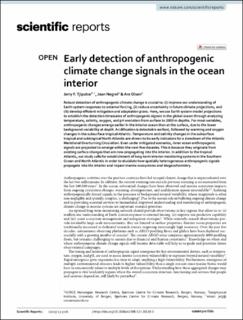Early detection of anthropogenic climate change signals in the ocean interior
Journal article, Peer reviewed
Published version

Åpne
Permanent lenke
https://hdl.handle.net/11250/3064429Utgivelsesdato
2023Metadata
Vis full innførselSamlinger
- Geophysical Institute [1198]
- Registrations from Cristin [9791]
Sammendrag
Robust detection of anthropogenic climate change is crucial to: (i) improve our understanding of Earth system responses to external forcing, (ii) reduce uncertainty in future climate projections, and (iii) develop efficient mitigation and adaptation plans. Here, we use Earth system model projections to establish the detection timescales of anthropogenic signals in the global ocean through analyzing temperature, salinity, oxygen, and pH evolution from surface to 2000 m depths. For most variables, anthropogenic changes emerge earlier in the interior ocean than at the surface, due to the lower background variability at depth. Acidification is detectable earliest, followed by warming and oxygen changes in the subsurface tropical Atlantic. Temperature and salinity changes in the subsurface tropical and subtropical North Atlantic are shown to be early indicators for a slowdown of the Atlantic Meridional Overturning Circulation. Even under mitigated scenarios, inner ocean anthropogenic signals are projected to emerge within the next few decades. This is because they originate from existing surface changes that are now propagating into the interior. In addition to the tropical Atlantic, our study calls for establishment of long-term interior monitoring systems in the Southern Ocean and North Atlantic in order to elucidate how spatially heterogeneous anthropogenic signals propagate into the interior and impact marine ecosystems and biogeochemistry.
